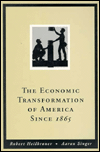

 |

|

The average rating for Economic Transformation of America 3E, Vol II based on 2 reviews is 4 stars.
Review # 1 was written on 2015-07-14 00:00:00 Christopher Lorraine Christopher LorraineHoly cow, do I love this book. Now, has a lot of its details been supplanted by continuing research in the 125 years since it was first published? Sure it has. But reading this book has given me a grounding in the structure of late Anglo Saxon/ early Norman society that has served me extremely well in the years since I first read it. (This most recent go-around was my third.) Maitland was extremely learned, extremely careful, and honestly, pretty readable. Now, this isn't necessarily for the casual reader. It *is* pretty dense. But I really like it, and you might too. |
Review # 2 was written on 2016-08-31 00:00:00 Todd Mozingo Todd MozingoThis is an extremely detailed study of High Medieval England. The author clearly expects the reader to have a significant background in the subject as the vocabulary, references, and data require an experienced hand with the material. Despite years of study and a MA in Medieval Europe, the language and analysis was too deep for me. I was frustrated by the sheer amount of raw data and a lack of defining the terminology. It took almost 300 pages before he defined "Sake and Soke." I am still uncertain of a proper definition: jurisdiction and the rights to jurisdiction? What does this mean? He spends a lot of time discussing it, but in abstract terms such as freedom, free-born, access to beasts of burden, etc. He spent even longer defining the term "hide," the measurement by which much of Domesday Book measured England. He concludes that 1 hide = 120 acres; but clearly demonstrates that the definition is much too simple and a range of 80-400 acres is more accurate. The average is 120 acres. The nobility like rounded figures. However, Maitland again and again argues that the basic feudal land holding for a knight was 5 hides or 600 acres. Some readers may be frustrated by reading 500+ pages of so detailed a study, but it provides a lot of insight into the kingdom of William the Conqueror. In order to fully benefit from reading it, one should read it twice with a vague understanding of the vocabulary to help explain some of the data. Rereading this book in 2017 has both increased my appreciation and reinforced my earlier complaints. Something that I missed completely reading it in 2011 was Anglo-Saxon society's determination to impose a complex social hierarchy. School has spoiled me into believing a simple system of lords, clergy, and everyone else. The third category was further stratified by free men, sokemen, bovars, cottars, servii, slaves, and probably others. Each title carried different obligations and freedoms. Social status also played a significant role in justice. Maitland argues that there were many overlapping jurisdictions such that the first part of an investigation was to determine who has authority over where the crime occurred, who has authority over the alleged criminal, who has authority over victim(s), who has authority over the captor, who has authority over the land where any pursuit took place, and who has authority over the land where the alleged criminal was captured. Maitland uses such detail to argue when lords granted land to others (lords or clergy), they were granting the rights to justice. Consequently, multiple lords or clergymen could claim a portion of any fines. The fines could be more reliable than harvests. They were also instant. Finally, the crushing legal system that this created forced many free men to lose status and becoming serfs quickly between the Norman Conquest and the ascendance of Edward I. He also makes repeated references to forgeries that always benefited the church. Overall, this is a really difficult read. Medievalists will learn something new each time. Maitland wrote a classic that has yet to be surpassed while at the same time showcasing how complex medieval history is to study. As desperate as he is to argue for multiple legal jurisdictions, and that a hide (usually) equals 120 acres, he offers readers a lot of contradictory data. |
CAN'T FIND WHAT YOU'RE LOOKING FOR? CLICK HERE!!!